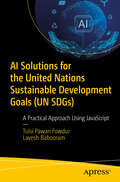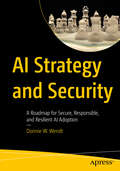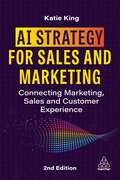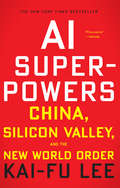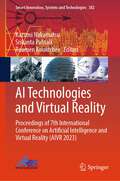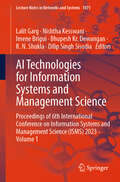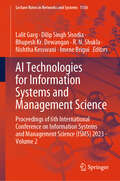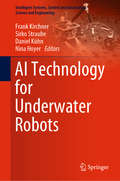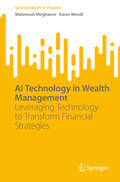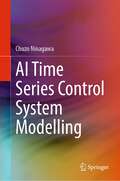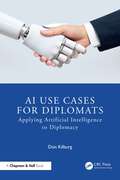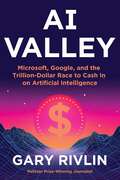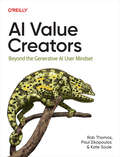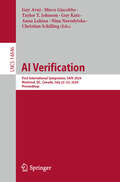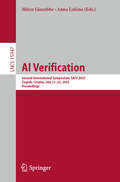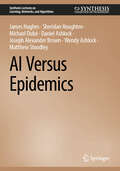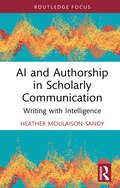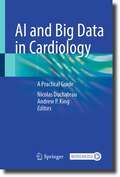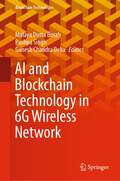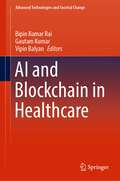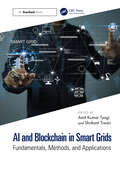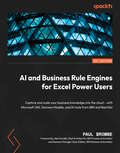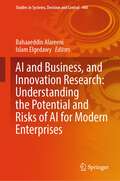- Table View
- List View
AI Solutions for the United Nations Sustainable Development Goals (UN SDGs): A Practical Approach Using JavaScript
by Tulsi Pawan Fowdur Lavesh BabooramLearn the United Nations Sustainable Development Goals (UN SDGs) and see how machine learning can significantly contribute to their realization. This book imparts both theoretical knowledge and hands-on experience in comprehending and constructing machine learning-based applications for addressing multiple UN SDGs using JavaScript. The reading begins with a delineation of diverse UN SDG targets, providing an overview of previous successful applications of machine learning in solving realistic problems aligned with these targets. It thoroughly explains fundamental concepts of machine learning algorithms for prediction and classification, coupled with their implementation in JavaScript and HTML programming. Detailed case studies examine challenges related to renewable energy, agriculture, food production, health, environment, climate change, water quality, air quality, and telecommunications, corresponding to various UN SDGs. Each case study includes related works, datasets, machine learning algorithms, programming concepts, and comprehensive explanations of JavaScript and HTML codes used for web-based machine learning applications. The results obtained are meticulously analyzed and discussed, showcasing the pivotal role of machine learning in advancing the relevant SDGs. By the end of this book, you’ll have a firm understanding of SDG fundamentals and the practical application of machine learning to address diverse challenges associated with these goals. What You’ll Learn Understand the fundamental concepts of the UN SDGs, AI, and machine learning algorithms. Employ the correct machine learning algorithms to address challenges on the United Nations Sustainable Development Goals (UN SDGs)? Develop web-based machine learning applications for the UN SDGs using Javascript, and HTML. Analyze the impact of a machine learning-based solution on a specific UN SDG. Who This Book Is For Data scientists, machine learning engineers, software professionals, researchers, and graduate students.
AI Strategy and Security: A Roadmap for Secure, Responsible, and Resilient AI Adoption
by Donnie W. WendtAI will fundamentally change the way business is conducted across most industries. Organizations that excel at leveraging secure, responsible AI to advance their strategic objectives will have a distinct advantage. Those that do not may see their market share erode. This book provides a guide for organizations to integrate AI in alignment with the organization's strategic goals. The framework provides a roadmap for adopting secure, responsible, and resilient AI, from initial strategy development to ongoing operations that will help advance market leadership. Part one of the book discusses laying a solid foundation to ensure successful AI integration, beginning with developing an AI strategy aligned with strategic business objectives, such as product and service differentiation, market expansion, and process optimization. Part Two takes a deep dive into ensuring secure and safe AI adoption. It proposes a secure-by-design approach to AI development that considers AI-specific attack vectors and associated security practices throughout the AI lifecycle. Developing and deploying secure, responsible, and resilient AI is not a one-time effort. Therefore, Part Three discusses operationalizing AI and integrating it throughout the enterprise to ensure continued success. This section focuses on scaling AI applications and continuous improvement, including establishing metrics and conducting a post-deployment ROI evaluation. Finally, it discusses how to foster a culture of AI innovation and excellence, ensuring that AI becomes a way of doing business. What You Will Learn: Develop an AI integration strategy aligned with the organization's strategic goals and objectives. Incorporate a secure-by-design approach to AI integration that considers AI-specific attack vectors and applies traditional and AI-specific defense methods, such as adversarial development, model behavior monitoring, drift analysis, input validation and filtering, and output filtering. Establish an AI governance and risk management framework to ensure ongoing compliance with applicable legislation, industry standards, organizational policies, and responsible AI principles. Operationalize and scale AI applications to ensure resilient production usage and facilitate continuous improvement. Foster a culture of AI innovation and excellence, ensuring that AI becomes a way of doing business. Who This Book is for: The primary audience includes business leaders, AI practitioners, AI executives, AI governance professionals, and cybersecurity leaders looking to integrate AI as a strategic differentiator and to enhance business operations. Higher education would be a secondary audience.
AI Strategy for Sales and Marketing: Connecting Marketing, Sales and Customer Experience
by Katie KingWhat do senior marketing leaders need to strategically leverage AI to deliver measurable business growth?The second edition of AI Strategy for Sales and Marketing offers proven frameworks and expert insights to help senior professionals harness artificial intelligence for customer-centric sales growth. This authoritative guide blends the latest research with practical tools, enabling informed leadership to navigate AI-driven personalization, team upskilling, omnichannel experiences and ethical governance. Featuring exclusive interviews with executives from L'Oreal, Salesforce and UOB, it equips leaders to deliver sustained ROI in an evolving landscape.You'll learn how to: - Apply strategic models to integrate AI across marketing and sales functions- Utilize data-led decision making to enhance customer experience and loyalty- Drive organizational change with AI-driven team development and productivity tools- Manage AI governance and ethical considerations to build consumer trust- New to this edition: Fresh interviews and real-world examples, new research illustrating the impact of AI in CX, actionable strategies to improve team productivity, updates to the ethical landscape globally and the introduction to a new framework called the AI PlaybookDesigned for senior marketing and sales executives, this guide empowers you to lead AI adoption that aligns with business objectives and delivers lasting results.Themes include: Strategic models, Leadership, Data-led decision making, Financial impact, Ethical AI governance
AI Strategy: Unleash the Power of Artificial Intelligence in Your Business
by Bernard MarrIs your business truly ready for the AI revolution? Discover how to unlock the full potential of artificial intelligence and future-proof your organization with a winning AI strategy.AI is transforming every industry - is your business keeping up? In this essential guide, bestselling author and futurist Bernard Marr provides a comprehensive playbook for leaders looking to harness the power of AI. From understanding AI's transformative impact to developing a clear, actionable strategy, this book equips leaders with the tools they need to drive innovation, manage risks, and stay ahead in an AI-driven world.AI Strategy is the definitive guide for leaders ready to unlock AI's potential at scale. Covering every aspect of AI adoption - from ethical considerations and data management to employee upskilling and tech infrastructure - this book delivers real-world examples across multiple organizations and industries, from energy, healthcare and education to marketing and HR. Whether you're just starting or scaling fast, this must-read guide will help you confidently build and execute a winning AI strategy.
AI Superpowers: China, Silicon Valley, and the New World Order
by Kai-Fu LeeDr. Kai-Fu Lee—one of the world’s most respected experts on AI and China—reveals that China has suddenly caught up to the US at an astonishingly rapid and unexpected pace. <P><P>In AI Superpowers, Kai-fu Lee argues powerfully that because of these unprecedented developments in AI, dramatic changes will be happening much sooner than many of us expected. Indeed, as the US-Sino AI competition begins to heat up, Lee urges the US and China to both accept and to embrace the great responsibilities that come with significant technological power. <P><P>Most experts already say that AI will have a devastating impact on blue-collar jobs. But Lee predicts that Chinese and American AI will have a strong impact on white-collar jobs as well. Is universal basic income the solution? <P><P> In Lee’s opinion, probably not. But he provides a clear description of which jobs will be affected and how soon, which jobs can be enhanced with AI, and most importantly, how we can provide solutions to some of the most profound changes in human history that are coming soon. <P><b>A New York Times Bestseller</b>
AI Technologies and Virtual Reality: Proceedings of 7th International Conference on Artificial Intelligence and Virtual Reality (AIVR 2023) (Smart Innovation, Systems and Technologies #382)
by Srikanta Patnaik Kazumi Nakamatsu Roumen KountchevThis book gathers a collection of selected works and new research results of scholars and graduate students presented at the 7th International Conference on Artificial Intelligence and Virtual Reality (AIVR 2023) held in Kumamoto, Japan during July 21-23, 2023. The focus of the book is interdisciplinary in nature and includes research on all aspects of artificial intelligence and virtual reality, from fundamental development to the applied system. The book covers topics such as system techniques, performance, and implementation; content creation and modelling; cognitive aspects, perception, user behaviour; AI technologies; interactions, interactive and responsive environments; AI/VR applications and case studies.
AI Technologies for Information Systems and Management Science: Proceedings of 6th International Conference on Information Systems and Management Science (ISMS) 2023 - Volume 1 (Lecture Notes in Networks and Systems #1071)
by Lalit Garg Nishtha Kesswani Imene Brigui Dilip Singh Sisodia Bhupesh Kr. Dewangan R. N. ShuklaThis book explores the integration of artificial intelligence into various facets of information systems and management. It delves into machine learning, natural language processing, and computer vision applications, illustrating how these technologies revolutionize decision-making, optimization, and data analysis. Through case studies and theoretical frameworks, the book elucidates the transformative potential of AI in enhancing organizational efficiency and strategic planning, making it an essential reading for professionals and researchers navigating the intersection of AI and business. This book also highlights the efforts to build ethical norms and frameworks for AI adoption in MIS, as well as data privacy and security considerations.
AI Technologies for Information Systems and Management Science: Proceedings of 6th International Conference on Information Systems and Management Science (ISMS) 2023 - Volume 2 (Lecture Notes in Networks and Systems #1136)
by Lalit Garg Nishtha Kesswani Imene Brigui Dilip Singh Sisodia Bhupesh Kr. Dewangan R. N. ShuklaThis text will be replaced by the correct informationtext as soon as we get it.
AI Technologies for Information Systems and Management Science: Proceedings of the 7th International Conference on Information Systems and Management Science (ISMS) 2024 (Lecture Notes in Networks and Systems #1479)
by Lalit Garg Nishtha Kesswani Imene BriguiThis book brings together leading experts, academics, and industry professionals to explore how AI is transforming decision-making, data analytics, operations, and strategic management across diverse sectors. Dive into the cutting-edge world of artificial intelligence with AI Technologies for Information Systems and Management Science, a comprehensive book is featuring peer-reviewed research from the 7th International Conference on Information Systems and Management Science (ISMS 2024). Covering topics such as intelligent systems, machine learning integration, AI-driven process optimization, and ethical considerations, this proceedings book offers a rich blend of theoretical insights and practical applications. Whether you're a researcher, practitioner, or student, you&’ll find valuable perspectives on how emerging AI technologies are reshaping the foundations of modern information systems and management practices. Gain inspiration from real-world case studies, stay ahead with the latest innovations, and deepen your understanding of AI&’s role in driving smarter, more adaptive organizations. With contributions from global thought leaders, this book is an essential resource for anyone interested in the future of intelligent business and digital transformation. Embrace the power of AI—empowering tomorrow&’s systems, today.
AI Technology for Underwater Robots (Intelligent Systems, Control and Automation: Science and Engineering #96)
by Frank Kirchner Sirko Straube Daniel Kühn Nina HoyerThis book provides exclusive insight into the development of a new generation of robotic underwater technologies. Deploying and using even the most simple and robust mechanical tools is presenting a challenge, and is often associated with an enormous amount of preparation, continuous monitoring, and maintenance. Therefore, all disciplinary aspects (e.g. system design, communication, machine learning, mapping and coordination, adaptive mission planning) are examined in detail and together this gives an extensive overview on research areas influencing next generation underwater robots. These robotic underwater systems will operate autonomously with the help of the most modern artificial intelligence procedures and perform environmental monitoring as well as inspection and maintenance of underwater structures. The systems are designed as modular and reconfigurable systems for long term autonomy to remain at the site for longer periods of time. New communication methods using AI enable missions of hybrid teams of humans and heterogeneous robots. Thus this volume will be an important reference for scientists on every qualification level in the field of underwater technologies, industrial maritime applications, and maritime science.
AI Technology in Wealth Management: Leveraging Technology to Transform Financial Strategies (SpringerBriefs in Finance)
by Karen Wendt Mahnoosh MirghaemiThis book explores AI technology in wealth management, including what it is, how it changes the wealth management and private banking landscape, its advantages, and how it democratizes wealth management. Specifically, this book investigates topics such as Hyper-personalized investment strategies Combined quantitative analysis with sentiment analysis to create prescriptive and predictive scenarios Expandable and transparent AI algorithms in wealth management Customer experience and client engagement Tailored financial content Providing a clear and concise description of how AI driven wealth management differs from traditional investing, asset management, and wealth management offering new opportunities for investing, this book is ideal for students, scholars, researchers and professionals interested in accessible wealth management applications for investing in the 21st century.
AI Time Series Control System Modelling
by Chuzo NinagawaThis book describes the practical application of artificial intelligence (AI) methods using time series data in system control. This book consistently discusses the application of machine learning to the analysis and modelling of time series data of physical quantities to be controlled in the field of system control.Since dynamic systems are not stable steady states but changing transient states, the changing transient states depend on the state history before the change. In other words, it is essential to predict the change from the present to the future based on the time history of each variable in the target system, and to manipulate the system to achieve the desired change. In short, time series is the key to the application of AI machine learning to system control. This is the philosophy of this book: "time series data" + "AI machine learning" = "new practical control methods".This book can give my helps to undergradate or graduate students, institute researchers and senior engineers whose scientific background are engineering, mathematics, physics and other natural sciences.
AI Use Cases for Diplomats: Applying Artificial Intelligence to Diplomacy (Chapman & Hall/CRC Artificial Intelligence and Robotics Series)
by Donald KilburgIn today’s rapidly changing world, diplomacy is undergoing a revolutionary transformation. Imagine ambassadors using artificial intelligence (AI) to analyze millions of social media posts in real time, crisis responses guided by predictive analytics, and complex negotiations enhanced by unprecedented data‑driven insights. This isn’t the future—it’s diplomacy today, reimagined through AI. Drawing on over 21 years of experience integrating technology into foreign affairs, Donald Kilburg, a retired U.S. diplomat, reveals how AI is revolutionizing diplomatic engagement, crisis management, and public diplomacy. From enhancing communication strategies to optimizing consular services, each chapter presents a vivid exploration of AI’s potential to amplify the effectiveness of diplomatic missions across the globe. Readers will discover practical strategies for implementing AI in diplomatic operations, gain insights into the future of AI‑driven global governance, and learn when—crucially—not to use AI at all. Through vivid case studies and real‑world examples, this book illuminates both the opportunities and ethical complexities at the intersection of technology and international relations. Whether you’re a diplomatic practitioner, a student of international affairs, or fascinated by technology’s impact on global relationships, this groundbreaking guide charts the course for diplomacy’s next evolution—where human wisdom and AI converge to address our world’s most pressing challenges.
AI Valley: Microsoft, Google, and the Trillion-Dollar Race to Cash In on Artificial Intelligence
by Gary RivlinA veteran Pulitzer Prize-winning journalist shadows the top thinkers in the field of Artificial Intelligence, introducing the breakthroughs and developments that will change the way we live and work. Artificial Intelligence has been “just around the corner” for decades, continually disappointing those who long believed in its potential. But now, with the emergence and growing use of ChatGPT, Gemini, and a rapidly multiplying number of other AI tools, many are wondering: Has AI’s moment finally arrived?In AI Valley, Pulitzer Prize-winning journalist Gary Rivlin brings us deep into the world of AI development in Silicon Valley. Over the course of more than a year, Rivlin closely follows founders and venture capitalists trying to capitalize on this AI moment. That includes LinkedIn founder Reid Hoffman, the legendary investor whom the Wall Street Journal once called, “the most connected person in Silicon Valley.”Through Hoffman, Rivlin is granted access to a number of companies on the cutting-edge of AI research, such as Inflection AI, the company Hoffman cofounded in 2022, and OpenAI, the San Francisco-based startup that sparked it all with its release at the end of that year of ChatGPT. In addition to Hoffman, Rivlin introduces us to other AI experts, including OpenAI cofounder Sam Altman and Mustafa Suleyman, the co-founder of DeepMind, an early AI startup that Google bought for $650 million in 2014. Rivlin also brings readers inside Microsoft, Meta, Google and other tech giants scrambling to keep pace.On this vast frontier, no one knows which of these companies will hit it big–or which will flame out spectacularly. In this riveting narrative marbled with familiar names such as Musk, Zuckerberg, and Gates, Rivlin chronicles breakthroughs as they happen, giving us a deep understanding of what’s around the corner in AI development. An adventure story full of drama and unforgettable personalities, AI Valley promises to be the definitive story for anyone seeking to understand the latest phase of world-changing discoveries and the minds behind them.
AI Value Creators
by Rob Thomas Paul Zikopoulos Kate SouleWe've arrived in a new era—GenAI is reshaping industries and decision-making processes across the board. As a result, understanding their potential and pitfalls has become crucial. But in order to stay ahead of the curve, you'll need to develop fresh perspectives on leveraging AI beyond mere technical know-how. Geared toward business leaders and tech professionals alike, this book demystifies the strategic integration of AI into business practices, ensuring you're equipped not just to participate but to lead in this new landscape. This insightful guide by industry leaders Rob Thomas, Paul Zikopoulos, and Kate Soule goes beyond the basics, offering real-life success stories and learned lessons to provide a blueprint for meaningful AI engagement. Whether you're a novice or a seasoned expert, you'll come away with an enhanced understanding of GenAI. Recognize the transformative potential of AI in business and how to harness itNavigate the ethical and operational challenges posed by AI with confidenceUnderstand the dynamic interplay between AI technology and business strategyImplement actionable strategies to integrate AI into your organizational cultureStep confidently into the role of an AI value creator, equipped to lead and innovate
AI Verification: First International Symposium, SAIV 2024, Montreal, QC, Canada, July 22–23, 2024, Proceedings (Lecture Notes in Computer Science #14846)
by Guy Katz Nina Narodytska Christian Schilling Guy Avni Mirco Giacobbe Taylor T. Johnson Anna LukinaThis LNCS volume constitutes the proceedings of the First International Symposium on AI Verification, SAIV 2024, in Montreal, QC, Canada, during July 2024. The scope of the topics was broadly categorized into two groups. The first group, formal methods for artificial intelligence, comprised: formal specifications for systems with AI components; formal methods for analyzing systems with AI components; formal synthesis methods of AI components; testing approaches for systems with AI components; statistical approaches for analyzing systems with AI components; and approaches for enhancing the explainability of systems with AI components. The second group, artificial intelligence for formal methods, comprised: AI methods for formal verification; AI methods for formal synthesis; AI methods for safe control; and AI methods for falsification.
AI Verification: Second International Symposium, SAIV 2025, Zagreb, Croatia, July 21–22, 2025, Proceedings (Lecture Notes in Computer Science #15947)
by Mirco Giacobbe Anna LukinaThis LNCS volume constitutes the proceedings of the Second International Symposium, SAIV 2025, in Zagreb, Croatia, during July 2025. The scope of the topics was broadly categorized into two groups. The first group, formal methods for artificial intelligence, comprised: formal specifications for systems with AI components; formal methods for analyzing systems with AI components; formal synthesis methods of AI components; testing approaches for systems with AI components; statistical approaches for analyzing systems with AI components; and approaches for enhancing the explainability of systems with AI components. The second group, artificial intelligence for formal methods, comprised: AI methods for formal verification; AI methods for formalsynthesis; AI methods for safe control; and AI methods for falsification.
AI Versus Epidemics (Synthesis Lectures on Learning, Networks, and Algorithms)
by James Hughes Daniel Ashlock Joseph Alexander Brown Sheridan Houghten Michael Dubé Wendy Ashlock Matthew StoodleyThis book presents algorithms and tools that are designed to model and extract information from personal contact networks, which represent which individuals in a population are physically in contact with one another. The authors developed these tools based on research they conducted during the COVID-19 pandemic, with the goal of improving responses to epidemics in the future. The book provides methods for modelling the transmission of infection across a population. The authors explain how an epidemic model can be used to strategically distribute vaccines and minimize the spread of a virus. The book shows how evolutionary computation, graph compression, and network induction can be utilized to manage issues that arise from an epidemic.
AI and Authorship in Scholarly Communication: Writing with Intelligence
by Heather Moulaison-SandyAI and Authorship in Scholarly Communication explores the role of artificial intelligence (AI) as it pertains to scholarly research and writing.Explaining what AI is and how it can be used by scholars, the book also focuses on aspects with the potential to change the scholarly communication landscape. Bringing together research on AI and writing from the scholarly literature in LIS and beyond, the book weaves together information about essential topics relating to AI and authorship. In laying out the primary concerns surrounding AI in the field of scholarly communication, Moulaison-Sandy considers how those concerns map to norms and practices in research and writing. The book likewise explores the future landscape of scholarly communication, an environment in which AI will continue to play an important role.AI and Authorship in Scholarly Communication will be of great interest to scholars, students, and practitioners and will be particularly useful to those studying AI or authorship from a library and information science (LIS) perspective. Researchers or practitioners working in higher education or with learning technologies will also find much to interest them within the pages of the book.
AI and Big Data in Cardiology: A Practical Guide
by Nicolas Duchateau Andrew P. KingThis book provides a detailed technical overview of the use and applications of artificial intelligence (AI), machine learning and big data in cardiology. Recent technological advancements in these fields mean that there is significant gain to be had in applying these methodologies into day-to-day clinical practice. Chapters feature detailed technical reviews and highlight key current challenges and limitations, along with the available techniques to address them for each topic covered. Sample data sets are also included to provide hands-on tutorials for readers using Python-based Jupyter notebooks, and are based upon real-world examples to ensure the reader can develop their confidence in applying these techniques to solve everyday clinical problems.Artificial Intelligence and Big Data in Cardiology systematically describes and technically reviews the latest applications of AI and big data within cardiology. It is ideal for use by the trainee and practicing cardiologist and informatician seeking an up-to-date resource on the topic with which to aid them in developing a thorough understanding of both basic concepts and recent advances in the field.
AI and Blockchain Technology in 6G Wireless Network (Blockchain Technologies)
by Ganesh Chandra Deka Malaya Dutta Borah Pushpa SinghThis book highlights future research directions and latent solutions by integrating AI and Blockchain 6G networks, comprising computation efficiency, algorithms robustness, hardware development and energy management. This book brings together leading researchers in Academia and industry from diverse backgrounds to deliver to the technical community an outline of emerging technologies, advanced architectures, challenges, open issues and future directions of 6G networks. This book is written for researchers, professionals and students to learn about the integration of technologies such as AI and Blockchain into 6G network and communications. This book addresses the topics such as consensus protocol, architecture, intelligent dynamic resource management, security and privacy in 6G to integrate AI and Blockchain and new real-time application with further research opportunities.
AI and Blockchain in Healthcare (Advanced Technologies and Societal Change)
by Gautam Kumar Bipin Kumar Rai Vipin BalyanThis book presents state-of-the-art blockchain and AI advances in health care. Healthcare service is increasingly creating the scope for blockchain and AI applications to enter the biomedical and healthcare world. Today, blockchain, AI, ML, and deep learning are affecting every domain. Through its cutting-edge applications, AI and ML are helping transform the healthcare industry for the better. Blockchain is a decentralization communication platform that has the potential to decentralize the way we store data and manage information. Blockchain technology has potential to reduce the role of middleman, one of the most important regulatory actors in our society. Transactions are simultaneously secure and trustworthy due to the use of cryptographic principles. In recent years, blockchain technology has become very trendy and has penetrated different domains, mostly due to the popularity of cryptocurrencies. One field where blockchain technology has tremendous potential is health care, due to the need for a more patient-centric approach in healthcare systems to connect disparate systems and to increase the accuracy of electronic healthcare records (EHRs).
AI and Blockchain in Smart Grids: Fundamentals, Methods, and Applications
by Amit Kumar Tyagi Shrikant TiwariAI and Blockchain in Smart Grids: Fundamentals, Methods, and Applications examines the cutting-edge solution that combines artificial intelligence (AI), blockchain technology, and digital twin concepts to innovate the management and optimization of electrical power distribution. This innovative approach enhances the resilience, efficiency, and security of electricity grids while providing real-time insights for grid operators and stakeholders. The book covers such key elements as using: Digital twins in smart grids to gather real-time data from various grid components AI-powered analytics to process the data generated by digital twins and to analyze this information to detect patterns, predict grid failures, and recommend adjustments to enhance a grid's performance Blockchain-based security to ensure the secure and transparent management of data within a smart grid, especially a tamper-resistant ledger to store information related to energy production, distribution, and consumption Decentralized data sharing to allow grid data to be shared securely among various stakeholders, including utilities, regulators, and consumers Grid optimization techniques to improve electricity distribution, reduce energy waste, and balance supply and demand efficiently Select real-world case studies and practical examples demonstrate how AI and blockchain are currently being applied to enhance grid management, energy distribution, and sustainability. By explaining to researchers, academics, and students how AI and blockchain can revolutionize electricity distribution and make grids smarter, more secure, and environmentally friendly, the book points to a future where grid operators, regulators, and consumers will benefit from real-time data and a resilient, efficient energy ecosystem.
AI and Business Rule Engines for Excel Power Users: Capture and scale your business knowledge into the cloud – with Microsoft 365, Decision Models, and AI tools from IBM and Red Hat
by Paul Browne Alex PorcelliA power-packed manual to enhance your decision-making with the application of Business Rules using KIE, Drools, Kogito, MS Excel, Power Automate, Office Script, and MS FormsPurchase of the print or Kindle book includes a free PDF eBookKey FeaturesExplore the business rule tools by implementing real-world examples to write sophisticated rulesDiscover how decision services solve current business challenges using AICombine rules with workflows and scripting to deploy a cloud-based production environmentBook DescriptionMicrosoft Excel is widely adopted across diverse industries, but Excel Power Users often encounter limitations such as complex formulas, obscure business knowledge, and errors from using outdated sheets. They need a better enterprise-level solution, and this book introduces Business rules combined with the power of AI to tackle the limitations of Excel.This guide will give you a roadmap to link KIE (an industry-standard open-source application) to Microsoft's business process automation tools, such as Power Automate, Power Query, Office Script, Forms, VBA, Script Lab, and GitHub. You'll dive into the graphical Decision Modeling standard including decision tables, FEEL expressions, and advanced business rule editing and testing.By the end of the book, you'll be able to share your business knowledge as graphical models, deploy and execute these models in the cloud (with Azure and OpenShift), link them back to Excel, and then execute them as an end-to-end solution removing human intervention. You'll be equipped to solve your Excel queries and start using the next generation of Microsoft Office tools.What you will learnUse KIE and Drools decision services to write AI-based business rulesLink Business Rules to Excel using Power Query, Script Lab, Office Script, and VBABuild an end-to-end workflow with Microsoft Power Automate and Forms while integrating it with Excel and KogitoCollaborate on and deploy your decision models using OpenShift, Azure, and GitHubDiscover advanced editing using the graphical Decision Model Notation (DMN) and testing toolsUse Kogito to combine AI solutions with ExcelWho this book is forThis book is for Excel power users, business users, and business analysts looking for a tool to capture their knowledge and deploy it as part of enterprise-grade systems. Working proficiency with MS Excel is required. Basic knowledge of web technologies and scripting would be an added advantage.
AI and Business, and Innovation Research: Understanding the Potential and Risks of AI for Modern Enterprises (Studies in Systems, Decision and Control #440)
by Islam Elgedawy Bahaaeddin AlareeniThis book provides a comprehensive overview of the latest trends and developments in AI and business innovation research. In today's rapidly changing business environment, artificial intelligence (AI) has become an essential tool for innovation and growth. From marketing and customer service to supply chain management and product development, AI is transforming the way businesses operate, allowing them to make better decisions and achieve their goals faster and more efficiently than ever before.However, the integration of AI into business operations is not without its challenges and risks. There are concerns about data privacy, cybersecurity, and the potential for AI to disrupt traditional industries and displace workers. As a result, it is essential for business leaders and researchers to understand both the potential and risks of AI, and how it can be effectively leveraged for business innovation.This book explores the potential benefits of AI for modern enterprises, including how it can be used to enhance customer service, optimize supply chain management, and improve decision-making in a range of business contexts. It also examines the role of AI in product development, marketing, and sales, and how it can be used to drive innovation and growth.The book also examines the risks and challenges associated with the integration of AI into business operations. It explores the ethical and legal implications of AI, including issues related to data privacy and security, bias in algorithms, and the impact of AI on employment and the labor market. It also examines the role of government and policymakers in regulating AI and managing the risks associated with its integration into business operations.Overall, this book provides a comprehensive and balanced perspective on the potential and risks of AI for modern enterprises.
